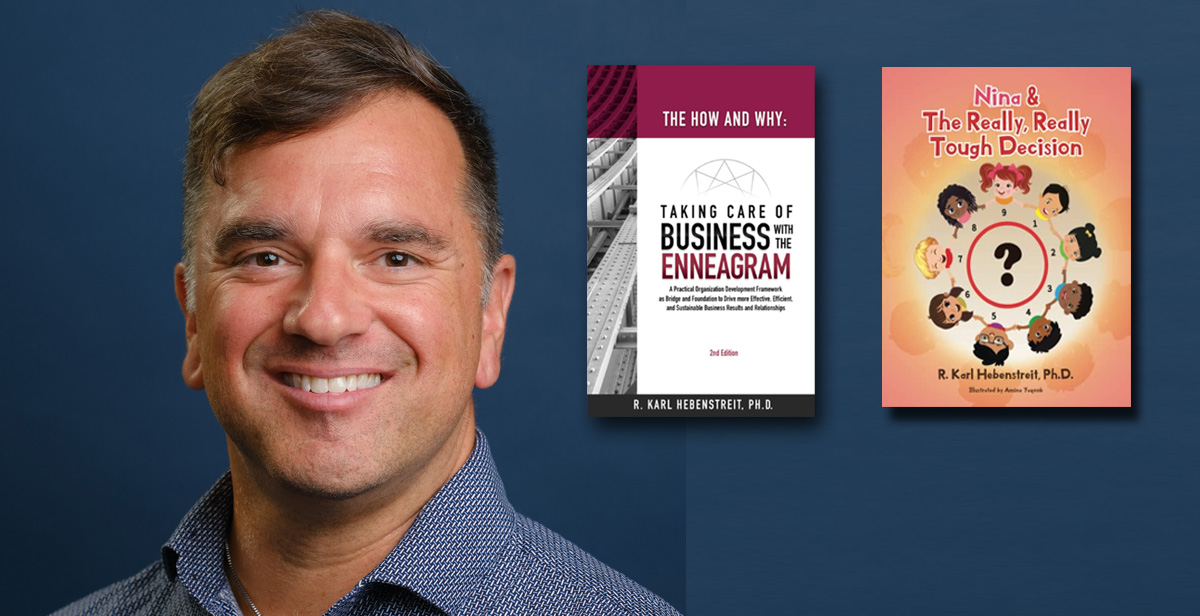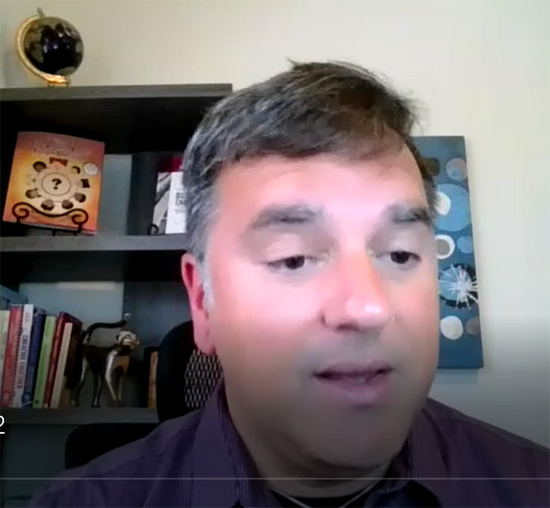Thought Leadership Studio Podcast Episodes:
Interview with R. Karl Hebenstreit- Taking Care of Business with the Enneagram
Episode 38 - Interview with R. Karl Hebenstreit- Lead and Persuade More Effectively by Using the Enneagram

#authors, #consulting, #hr, #influence, #insight, #interviews, #leadership, #marketing, #marketlistening, #marketresearch, #massinfluence, #mentaltraining, #thoughtleadership, #thoughtleadershipexamples
Or Click here to listen or subscribe on appWhat this episode will do for you
- Learn about the Enneagram, a tool for understanding the motivation and behavior of individuals through their personality types.
- Learn from R. Karl Hebenstreit's journey in discovering the Enneagram and how it has helped him in his work as a human resources consultant.
- Begin to learn to use the Enneagram to better understand individuals and communicate with them more effectively, especially in terms of marketing and thought leadership.
- By understanding the nine different lenses through which people view the world, gain a better understanding of others and be more inclusive in their communication.
R. Karl Hebenstreit, Ph.D., PCC, PHR - Executive Coach, Author, International Speaker.
Karl is a Human Resources and Organization Development Professional with over 25 years experience in the biotechnology, pharmaceutical, healthcare, telecommunications, high-tech, and real estate services industries.
Karl is the author of Nina & the Really, Really Tough Decisions, and The How and Why: Taking Care of Business with the Enneagram.
Karl's website is at www.performandfunction.com.
Curated Transcript of Interview with R. Karl Hebenstreit
The following partial transcript is lightly edited for clarity - the full interview is on audio. Click here to listen.
Chris McNeil: I'm Chris McNeil, host of Thought Leadership Studio, and I am sitting here with Karl Hebenstreit, expert in the Enneagram, author of multiple books, including Nina & the Really, Really Tough Decisions, and also The How and Why: Taking Care of Business with the Enneagram, a Practical Organizational Development Framework as Bridge and Foundation to Drive More Business Results and Relationships. And Karl is also a speaker and organizational development consultant and executive coach. Welcome Karl. Glad to have you here... or there, via Zoom ...
 R. Karl Hebenstreit: Great to meet you. Chris
R. Karl Hebenstreit: Great to meet you. Chris
Chris McNeil: Where are you talking with me from, Karl?
R. Karl Hebenstreit: LaQuinta, California, which is in Coachella Valley, right by Palm Springs.
Chris McNeil: Excellent. I'm on the other side of the country in Charleston, South Carolina. It's great to have you here. And for our listeners, to get a grasp on the kind of territory we might start to cover - kind of a view of the map, so to speak - can you give us a brief history of how you first encountered the Enneagram and, and what it meant to you and what you feel it can do for others?
R. Karl Hebenstreit: Yeah, thank you.
First Encounter of the Enneagram
So I first encountered the Enneagram in a PhD program. I had been practicing human resources management and HR consulting, and had been using the Myers-Briggs type instrument, so everyone knows about that one: extrovert, introvert, you know, all that ... judging, thinking, sensing feeling, and all that, all that kind of stuff. And it explained a lot and it helped to get people to understand a lot more about where they get their energy, how they make their decisions, what they look for first, whether they're looking for big picture, they're looking for detail, and then how do they organize their lives.
That's great because that's all behavioral categorizations. And it's great to understand ... oh, some people are gonna be more detail oriented and some people are gonna be more big picture oriented. So when I talk to them, I need to have that kind of perspective so that I don't bore them ... things along those lines. And that explained a lot.
That was great. That was a great introduction for it, but it didn't get to why, what's the reason behind those behavioral manifestations? And then when I was in my PhD program for Organizational Psychology, one of our teachers, one of our professors had a friend who is Helen Palmer. And Helen Palmer, unbeknownst to me at the time, because I didn't know who she was or where she came from or what she did, but she is one of the principal reasons why the Enneagram has become so pervasive and so out there in the modern world, because before she chose to write down some more public and modern interpretations of how to use the Enneagram.
It was a very esoteric and spiritual development practice before that. So her writings of the learnings that she got from the Enneagram, from an actual Enneagram practitioner that she had through a friend of hers who was taking coursework with him that got it out in the world, she came and she came to one of our classes and she introduced us to Enneagram.
And that just blew my mind. That was just, wow, this just explains a lot. And back then again, I was in human resources and I was involved in a lot of recruitment, and I came to the realization understanding that we are not doing what we need to do to be attracting this diverse perspective that we need in every organization, because we're only focusing on maybe two or three that to get these two or three people by using the language that these two or three people, people would want and would resonate with.
The Enneagram for Influence
So what if we changed our practices, became more inclusive, understood that we need the diversity of all these nine perspectives and nine motivations and drivers, and really reached out to people using their language. So (it's about) influence. I know a lot of the work that you do for, for the marketing and thought leadership that you do is all about influence.
So we can only influence people if we're talking to them in their language and, and telling them and speaking to them about what they want and what they understand and how to get them from their pain point to a solution. If we only reach out to them through our perspective and our using our language, and they're not speaking that same language, they're not coming at it from that same viewpoint, we're gonna shut them down. They're gonna shut down. They're gonna not think that we understand them. They're gonna go somewhere else. They're gonna be dissatisfied.
 So when I finally went through the program and then got deeper into the knowledge of the Enneagram and saw the power of it and how these nine different perspectives were really out there in, throughout the entire world, not just, this is just not an American thing or anything, it's throughout the entire world and understood that people are viewing the world with these nine different lenses. And if we understood that and integrated it into our own way that we're looking into the world, we'd really have a much better understanding of everything that's going on as opposed to just that tiny little sliver that we see.
So when I finally went through the program and then got deeper into the knowledge of the Enneagram and saw the power of it and how these nine different perspectives were really out there in, throughout the entire world, not just, this is just not an American thing or anything, it's throughout the entire world and understood that people are viewing the world with these nine different lenses. And if we understood that and integrated it into our own way that we're looking into the world, we'd really have a much better understanding of everything that's going on as opposed to just that tiny little sliver that we see.
Chris McNeil: Interesting. So, and for the listener, just realize I am a complete absolute beginner at the Enneagram, and I'm fascinated by it. So I'm likely going to ask some "stupid" questions ...
R. Karl Hebenstreit: No stupid question except the one that's not asked. Right?
Chris McNeil: That's right. That's where I was going. And, and maybe other people who are beginning as I am to start to learn about it will be aided by that in some way. So would you say the engrams are nine different ways of creating our models of the world? Nine different styles?
R. Karl Hebenstreit:You could definitely say that.
Chris McNeil: ... and, by understanding "I am naturally more this one type, but there's these other eight types. " that helps us to better enter others' models of the world by learning to be more flexible and thinking as the other eight types a little better. Would that be fair to say?
R. Karl Hebenstreit: That's exactly it. And, and, and we have all nine of these within us, all nine of those, these exist within us. It's just that we rely on one over all the other eight.
Chris McNeil: Interesting. So people usually predominate very strongly in one naturally. Um, is it possible for someone by repetition and practice to change that? Or is it really hardwired?
R. Karl Hebenstreit: Yes, and yes, (laugh).
Chris McNeil: Okay, fair enough.
A Way of Better Understanding Others
R. Karl Hebenstreit: So it is the, the theory and the understanding ... the way that we understand the Enneagram is just like with most other systems and types that are out there, Myers Briggs and Leadership Circle, and Hogan, all these ways that we've come to being and understanding the world are a combination of nature and nurture. So we're pre-wired, hardwired, as you said, to a certain way.
And then our childhood development has solidified that and made that even more hardwired because that's how we survived our childhood. That's what we, that's what was necessary for us to get an understanding of what it was like to be in the world. And then we grew these muscles and that muscle memory to, to get always to that perspective because it served us well to get us through our childhood, because we're here now, right?.
Chris McNeil: (affirmative)
R. Karl Hebenstreit: ... and we just keep leaning on that. We keep going back to that, it's our default. And the reality is that not every single situation that we're currently facing is the same situation as our childhood. So that may not be the best approach, that may not be the best way of understanding the, the situation and approaching it and, um, really dealing with it. So wouldn't it be great to employ these other eight systems, these other eight ways of looking at the world and see if maybe those could help provide a better understanding of what's really going on, and a better toolkit to respond to what's really going on.
Chris McNeil: That's excellent. As you know, I'm a big believer in how multiple perspectives give more wisdom and choice and just about any situation.
Maybe to drill down and, and bring it out the abstract a little bit, can you give us a concrete example that someone who's wanting to be better at large scale persuasion might see as relevant?
R. Karl Hebenstreit: So salespeople, right? Salespeople go out there and they make ... I'll give you an example of of how I didn't know the engram at the time. So this was a huge lesson for me. So we're always taught the golden rule. The golden rule is, is taught and pervasive, and everyone knows the golden rule about do unto others the way that you'd have done unto you. And so that's basically what sales is. Sales is, this is my understanding of, you know, the benefits of this, this program, this product, this service, whatever it is, I'm gonna go out and tout it that way because this is what's important to me.
The reality is what's important to me may not be what's important to somebody else. So the golden rule does not apply there. I don't want to be receiving this information this way because that, that, that means nothing to me. I'm not interested in this part, I'm interested in this other part that you're not talking about. So then the platinum rule is do unto others the way they have done onto them. So how they wanna be treated, treat others the way they wanna be treated. So if we can figure out a way to find out how others want to be treated, and we're not mind readers, so I don't, maybe you're a mind reader. I, I'm just assuming that you're not a mind reader.
Chris McNeil: A little bit.
R. Karl Hebenstreit: A little bit, a little bit. Got it. (laugh), so you know this already.
Chris McNeil: I'm trying to be respectful with it and only read what people are willing to divulge.
R. Karl Hebenstreit: (laugh). There you go. Yeah. So if, if we can figure out what people want, and now we know that it fits into these nine categories, and if we can ask questions, we can find out what's important to them, what are their challenges, what, what did they need in this product, service, whatever it is, and then focus our presentation on that.
That's what's gonna be important to them, and we're gonna be, be able to build trust with them because they're going to know that we now understand their needs as opposed to just approaching it from this one perspective that may be totally irrelevant to them.
Chris McNeil: So there's a component of getting out of our own heads.
R. Karl Hebenstreit: Absolutely. Exactly.
 We're getting out of our own heads, but also maybe even getting deeper into our heads because - and then our heads, our hearts and our guts - because we're then looking at things through additional perspectives. So we're integrating all those nine perspectives in addition to our own head's perspective, right? So we want that full integration that way.
We're getting out of our own heads, but also maybe even getting deeper into our heads because - and then our heads, our hearts and our guts - because we're then looking at things through additional perspectives. So we're integrating all those nine perspectives in addition to our own head's perspective, right? So we want that full integration that way.
So the example I was gonna provide that happened to me at an early age without my knowledge of the Enneagram, and probably utilizing a lot of golden rule there, is I went out and I had to do a presentation at a conference about this product, and I went out and I did my spiel according to what I thought was going to be what the people in the audience needed. And I realized, no, that that was not important to them. People were leaving, people just got up and left because that's not what their expectations were.
Their expectations weren't being met. Luckily, I had two sessions. So the second session I decided, okay, that was a failure. So what went wrong? Let me figure out what they want. So then you know, you cue the spice girls in there, tell me what you want, you really, really want. Right? (laugh). So then the second one, the second session I started with, what do you expect? What do you need? What are your challenges? What are your pain points? Because I don't know, I can't read your minds right now.
So when people told me what they wanted from the session, what they expected from the product, I was able to gear the presentation to their needs. So it's a similar concept. So I'm finding out not what I think that they want, but what they really do want by creating more of a relationship with them, by understanding where they're coming from, what's important to them, and then arranging the presentation or the communication or the, the style to what they want and what's gonna be important to them, rather than shutting them down or shutting them off.
Chris McNeil: And you bring up the influence style as a part of that.
R. Karl Hebenstreit: Absolutely.
Chris McNeil: So please give us an example of one of the types and another type and how that first type would adapt their influence style to the second type.
 R. Karl Hebenstreit: Yeah. So the quickest thing that came to mind is one of the logic and details and evidence i an influence style, right? People may wanna know, "gimme the evidence, gimme the facts, gimme the details", and the types that would probably be most responsive to that would be a type five, which is the observer or analyst.
R. Karl Hebenstreit: Yeah. So the quickest thing that came to mind is one of the logic and details and evidence i an influence style, right? People may wanna know, "gimme the evidence, gimme the facts, gimme the details", and the types that would probably be most responsive to that would be a type five, which is the observer or analyst.
So if you have an observer, analyst, potential client or person that you're working with, and you're reaching out to them and going with all the "no, you have to do this", and you're directive to them, and they're not responding that style, or you're very much relationship oriented and you're trying to build a relationship and you're not really getting into the details, they're not gonna respond to that style. They want to know, gimme the evidence, show me testimonials, show me the data, show me reports, show me statistics of the efficacy of this product or service, or whatever it is.
So you'd have to change your influence style to meet those specific parameters at the type five would be most interested in.
Chris McNeil: Interesting. Okay. So there are different ways that people make decisions. So eliciting their decision strategy might be one way to identify their type and adapt to that.
R. Karl Hebenstreit: Just asking them "what's important to you, what are you looking for?" Rather than, than thinking that you know, wwhat they want or what's important to them, really asking them. And then realizing that some people are gonna be more about the relationship and the stakeholders and the customers and how it's gonna impact the customers. Some people are gonna be more about quality.
I wanna make sure that this is the best product, that there's no other better product. Maybe it's going to be more along the lines of sustainability. And maybe it's gonna be more along the lines of, is this ethically sourced, you know, things, these would be much more important to different types than other types.
Chris McNeil: So how about questions? Like, what's important to you and how would you know, what would be your evidence that you have met this value? Would that be a fair way to discover that?
R. Karl Hebenstreit: Absolutely. That's a great question. Tell what your pain points are. What are you looking for in a solution? How would you know that exactly? Like you said that we've, we've reached out for you that we've attained that for you.
Chris McNeil: I know there's a lot of ground to cover, and I don't expect us to be able to do a deep dive in any one of these. Can you give us a quick overview of the different types and how each other, and how they're sorted into those different types?
R. Karl Hebenstreit: Yeah. So I am going to do that. I'll probably give you a very quick overview of all nine types, because I can do that. And don't expect to land on your type just from this.
Chris McNeil: Understood.
R. Karl Hebenstreit: But some of these may resonate with you more than others. So if two or three of these are like, "yeah, totally, that's totally the way I approach this, or the way I view this", keep those in mind. Because those may either be your core type, they may be where you go under stress, they may be where you go under comfort, because each type has an automatic line that attaches and goes to another type on the circle under stress and under comfort.
And then there's a different way that you approach how you access your thinking style, your feeling style, and your action style. So you may be picking up on those three things when you pick up your top three.
Chris McNeil: I was going to ask if it is context dependent, and it sounds like there is some context dependency.
Contrasting the Types
R. Karl Hebenstreit: Your core type is your core type, and it will fall into either a, the head center, the thinking style. There are three that are in this thinking style. ... Your heart center, there are three that fall into the, the heart style, the feeling style. And then there are three that are your action style that fall into the action.
So the context is going to be what do you need to do in this situation? Or is, you know, when do you need to think? Do you need to feel, do you need to act? And it could also be dependent on, am I under stress? And then that could be something that really comes into play into which style you end up adopting. So I'll start off and put them in those styles.
I'll start with the feeling styles. The twos, the threes and the fours are the feeling styles. The heart center types. That's how each of us accesses our heart through one of these three styles. So the type two is the helper or giver - they have a very interesting superpower of intuition, intuitively knowing what other people need, which is good and bad, because it can be good if the person wants help, and they are totally okay with the person intervening and providing that help. It can be bad if they feel like this isn't imposition, so the, the other person doesn't want help and that it's being given without their, their consent or, or wanting it. So that could be, that could lead to something bad. So the twos are really, really great about being, knowing what people want and pro being able to provide that for them.
Chris McNeil: Okay.
R. Karl Hebenstreit: The threes are all about the goal, all about the achievement of the goal, really efficient, really able to change and morph to fit the situation. And it's all about achieving that goal. So that's their main focus, and that's their superpower.
 The fours are really more grounded in themselves. They're more in touch with their feelings. They're empathic to other people's feelings, they're very artistic. They're very into nature. It's all about the beauty and the authenticity of the really deep attachment to feelings and purpose. For the fours. And they are the artists, or romantics. The threes, by the way, are the performers are achievers.
The fours are really more grounded in themselves. They're more in touch with their feelings. They're empathic to other people's feelings, they're very artistic. They're very into nature. It's all about the beauty and the authenticity of the really deep attachment to feelings and purpose. For the fours. And they are the artists, or romantics. The threes, by the way, are the performers are achievers.
So, so we access our heart, our feelings through one of those three styles. Then we can access our thinking, our head through one of these three styles, the five, six, or seven, we talked about the five a little earlier being the observer or analyst, really into data, really into seeing how things work, the mechanics of things, making sense of things, creating models to make sense of the worlds of its predictable and safe.
So they can predict what's gonna happen, and then they feel safe that way. So they're all about knowledge and data. And that's what they do really. They're very objective, the sixes of the loyal skeptics. And they're really, really good at looking at the worst possible case scenario and planning for it in every single situation. So they will have a backup plan, a contingency plan to make sure that they're successful, safe, comfortable, and secure. So the sixes have that always looking out for the negative thing that's gonna happen and being prepared for it, planning for it.
And the sevens that's all about options and opportunities and excitement and, and experiences and fun. Um, very charismatic people, very visionary. So that's what they bring to the table. They're the epicures or adventurers mm-hmm. So that rounds up the three thinking styles that we have.
And then the action styles or gut center is the eight, nine, and type one. So the eight is the boss, the challenger, protector, general. they're all about justice and the power and control and authority, looking out for the underdog, protecting their, their inner circle, the people who are important to them. they will approach you very extroverted. There's will be a lot of passion, there'll be a lot of energy that you're gonna feel. It's palpable. And they will talk to you through debate. They will debate with you. And they're perfectly fine with conflict because they see it as a way to get to truth. And they're very interested in what's the truth? What's the situation, what's the truth? Okay, fine, we'll deal with it. Whatever. It doesn't matter if it's bad or good, whatever it is, we're, that's fine, let's work through it.
So that's the type eight. The nine is the mediator or peacekeeper. And they're more about, hold on, too much conflict. Let's just all get along. Let's all get along. Peace and harmony. And, um, they're very good at seeing all perspectives, um, like a systems thinking perspective. And they value every single perspective equally.
And the type one is the perfectionist or reformer. They're all about doing the right thing. So they all have their, whatever set of values they have that they've been raised with, that they've adopted, everything goes through that lens of what is the right thing to do in this situation? What's the ethical thing to do according to their values? So two type ones, they may have different value structures, would not agree sometimes well, well, they won't, if they have different value structures, they won't agree. And they, they could have conflict that way.
So they're really, really good at seeing the differences between things and seeing that this is a better option according to whatever value structure they have. So those are the nine types just in a nutshell, really, really quickly, each of them has a superpower that they bring to the table, to the party, to the team, to the organization. Sure. And each of them obviously is gonna be interested in something different in a, in a conversation with them and a relationship with them. Different things are going to be important to them.
Chris McNeil: Do you find that teams tend to self-organize into a balance of these roles?
R. Karl Hebenstreit: No. (laugh).
Chris McNeil: More like, like attract like?
R. Karl Hebenstreit: Exactly.
.............
The transcript is lightly edited for clarity and is a partial transcript- the full interview is on audio. Click here to listen.

Are you tired of your company's online presence falling short of your expectations? Look no further than 5th Level Web - the web development and internet marketing company that makes the internet turn-key for companies with $5-$100M in annual sales.
5th Level Web is for market leaders. We make sure your web presence reinforces and supports your leadership.
At 5th Level Web, we have high-level tech experts on hand to ensure quick response times and top-notch service. Our team will work with you to create a compelling message and web presence that sets you apart from the competition, establishing your company as a market leader with the THAUT process of strategic thought leadership.
Click Here to schedule your free offer as a listener/reader of Thought Leadership Studio: a Free Web Analysis and Consultation.
***************************************
Free Stuff and Offers Mentioned in Podcast
***************************************
***************************************